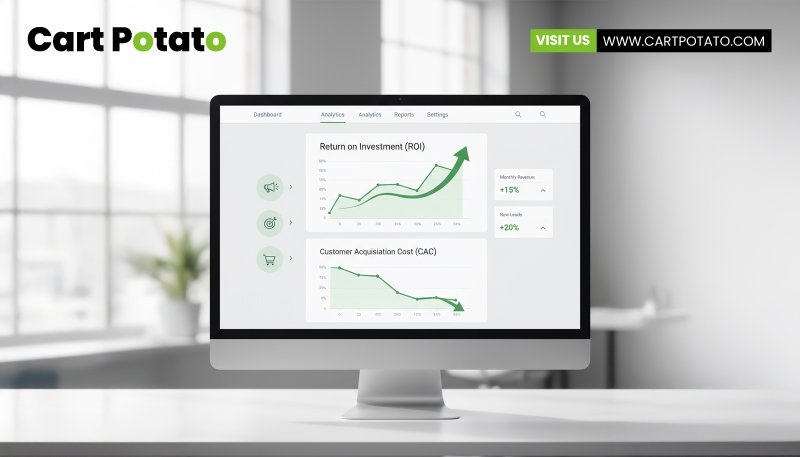
Modernizing B2B Commerce: Operationalizing EDI with Cloud OMS
The world of B2B commerce is rapidly evolving. With rising buyer expectations and growing demands for seamless, digital-first purchasing experiences, businesses face a pivotal challenge: how to meet these expectations without incurring additional overhead and inefficiencies.
Enter the integration of Electronic Data Interchange (EDI) with modern, cloud-based Order Management Systems (OMS) like Shopify. At Cart Potato, a Shopify and Shopify Plus exclusive agency, we recognize the transformative potential of connecting traditional B2B practices with cutting-edge technology. This blog explores how operationalizing EDI using Shopify’s cloud OMS can streamline operations, enhance scalability, and elevate customer satisfaction for B2B enterprises.
The Changing Face of B2B Commerce
B2B commerce has undergone a seismic shift in recent years. While traditional methods like sales rep negotiations and offline account management remain important, digital channels now dominate buyer preferences.
Here’s what defines today’s B2B landscape:
- Self-Serve Buying Portals:
Digital portals are now central to B2B operations, enabling buyers to explore products, manage orders, and settle invoices without needing manual intervention. These portals are becoming more sophisticated, incorporating features like tailored buying journeys, post-purchase notifications, and sales rep negotiation capabilities. - Offsite Digital Transactions (EDI & eProcurement):
Despite the rise of ecommerce, EDI and eProcurement remain critical for handling high transaction volumes. Large retailers still rely on EDI for vendor management, making it essential for B2B brands to adopt these technologies. - Offline Interactions:
While digital-first channels are rising, traditional sales and account management remain crucial for building strong relationships and offering personalized service. The challenge is integrating offline interactions with digital tools for a seamless experience.
Why EDI Integration Matters
EDI has long been a trusted tool for exchanging business documents quickly and accurately. However, without proper integration with modern systems, EDI can become a bottleneck. That’s where Shopify’s cloud OMS comes in.
Benefits of Integrating EDI with Shopify OMS
- Operational Efficiency:
Automation of order processing eliminates manual data entry, reduces errors, and ensures faster execution. Shopify’s OMS serves as a principal ingestion point for orders, enabling automated workflows for complex order-routing, decision trees, and freight integrations. - Scalability:
A cloud-based OMS like Shopify supports growing transaction volumes without requiring proportional increases in infrastructure. This scalability ensures businesses can expand operations seamlessly while maintaining efficiency. - Real-Time Data Access:
With real-time insights into order status, inventory, and customer details, businesses can make informed decisions quickly. This transparency also enhances collaboration across teams, improving overall productivity. - Enhanced Customer Experience:
Integrating EDI with Shopify’s OMS enables faster order fulfillment and greater accuracy, resulting in higher customer satisfaction. Buyers can track orders, receive updates, and manage payments in real-time, creating a seamless and delightful experience.
Simplifying Integrations
Historically, EDI integrations were complex, requiring point-to-point connections tailored to each trading partner. Modern solutions like Shopify, combined with advanced EDI management platforms like SPS Commerce and Orderful, simplify this process.
How It Works
- EDI Management Platforms: These platforms act as conduits, standardizing data models and simplifying document exchanges (e.g., purchase orders, invoices).
- Shopify OMS Integration: EDI documents are seamlessly converted into Shopify order records, enabling businesses to process orders without adapting to each trading partner’s specific requirements.
This streamlined approach reduces complexity and allows businesses to focus on what matters most—delivering value to their customers.
Future-Proofing B2B Operations
Integrating EDI with Shopify’s OMS isn’t just about solving current challenges—it’s about future-proofing your business. As buyer expectations evolve, businesses must adopt tools that offer scalability, real-time insights, and seamless digital experiences.
By operationalizing EDI with Shopify’s cloud OMS, businesses can:
- Harmonize traditional and digital commerce channels.
- Leverage real-time data for analytics and automation.
- Scale operations effortlessly while maintaining efficiency.
- Deliver standout customer experiences that drive loyalty and growth.
Why Choose Cart Potato for Your EDI Integration?
At Cart Potato, we specialize in helping B2B brands harness the full potential of Shopify and Shopify Plus. Our expertise in ecommerce solutions, combined with our deep understanding of B2B commerce, makes us the ideal partner for integrating EDI with Shopify’s OMS.
From seamless integrations to custom solutions tailored to your business needs, we ensure your operations are streamlined, scalable, and future-ready.
Ready to Transform Your B2B Operations?
The future of B2B commerce lies in the integration of traditional processes like EDI with modern, cloud-based systems like Shopify OMS. Let Cart Potato help you unlock the full potential of your business.
Contact us today to learn more about our Shopify solutions and how we can help you operationalize EDI for a competitive edge. Together, we’ll shape the future of your B2B commerce journey.
FAQs: Modernizing B2B with EDI Integration and Cloud-Based OMS
1. What is EDI, and why is it important for B2B commerce?
EDI (Electronic Data Interchange) is a standardized system that allows businesses to exchange documents such as purchase orders, invoices, and shipping notices electronically. It is essential for B2B commerce because it reduces manual errors, improves processing speed, and ensures compliance with trading partner requirements.
2. What is a cloud-based OMS, and how does it work with EDI?
A cloud-based Order Management System (OMS), like Shopify’s OMS, streamlines order processing, inventory management, and fulfillment. When integrated with EDI, it enables automated workflows, real-time data sharing, and seamless communication between trading partners and internal systems.
3. Why should businesses integrate EDI with Shopify’s cloud OMS?
Integrating EDI with Shopify’s OMS allows businesses to automate order processing, enhance scalability, gain real-time visibility into operations, and provide better customer experiences. It eliminates the complexities of managing separate systems and enables a unified commerce approach.
4. Can integrating EDI with a cloud-based OMS help scale my business?
Yes, integrating EDI with a cloud OMS helps businesses handle increased order volumes without adding overhead. It automates workflows and ensures systems can scale with growing demand, improving efficiency and profitability.
5. How does EDI integration enhance operational efficiency?
EDI integration eliminates the need for manual data entry, reduces errors, and automates order fulfillment. This streamlines processes, allowing businesses to allocate resources more effectively and improve overall operational efficiency.
6. What challenges can businesses face during EDI integration?
Challenges include the complexity of setting up point-to-point integrations with trading partners, ensuring data accuracy, and aligning EDI transactions with OMS workflows. However, using tools like Shopify’s OMS, paired with platforms like Orderful or SPS Commerce, simplifies this process.
7. Is EDI still relevant with the rise of ecommerce?
Yes, EDI remains crucial for handling large transaction volumes and meeting retailer requirements. While ecommerce is growing, EDI continues to play a key role in B2B operations, especially for digitally native brands working with established retail partners.
8. How can real-time data from an OMS benefit my business?
Real-time data access provides visibility into order status, inventory levels, and customer information. This transparency helps businesses make informed decisions quickly, improve customer service, and adapt to market demands efficiently.
9. What role does Shopify’s OMS play in enhancing customer satisfaction?
Shopify’s OMS streamlines order accuracy, improves delivery times, and offers tools for tracking orders and managing invoices. These features create a seamless and satisfying experience for B2B customers.
10. How long does it take to set up EDI integration with Shopify’s OMS?
With traditional systems, EDI setup can take weeks or months. However, leveraging platforms like Shopify’s OMS and EDI management solutions such as SPS Commerce or Orderful significantly reduces implementation time.
11. Can EDI integration support other business functions beyond order management?
Yes, EDI data can be used for analytics, inventory management, and even merchandising. Extracting business intelligence from EDI transactions helps businesses optimize operations and identify growth opportunities.
12. How can Cart Potato help with EDI and OMS integration?
As a Shopify and Shopify Plus agency, Cart Potato specializes in creating seamless EDI integrations with Shopify’s cloud OMS. We help businesses streamline their B2B operations, scale efficiently, and deliver exceptional customer experiences.
13. How do I get started with integrating EDI into my Shopify OMS?
Start by assessing your current systems, identifying operational inefficiencies, and consulting experts like Cart Potato. Our team can guide you through the process, ensuring a smooth and successful integration tailored to your business needs.
Contact us today to learn more!








